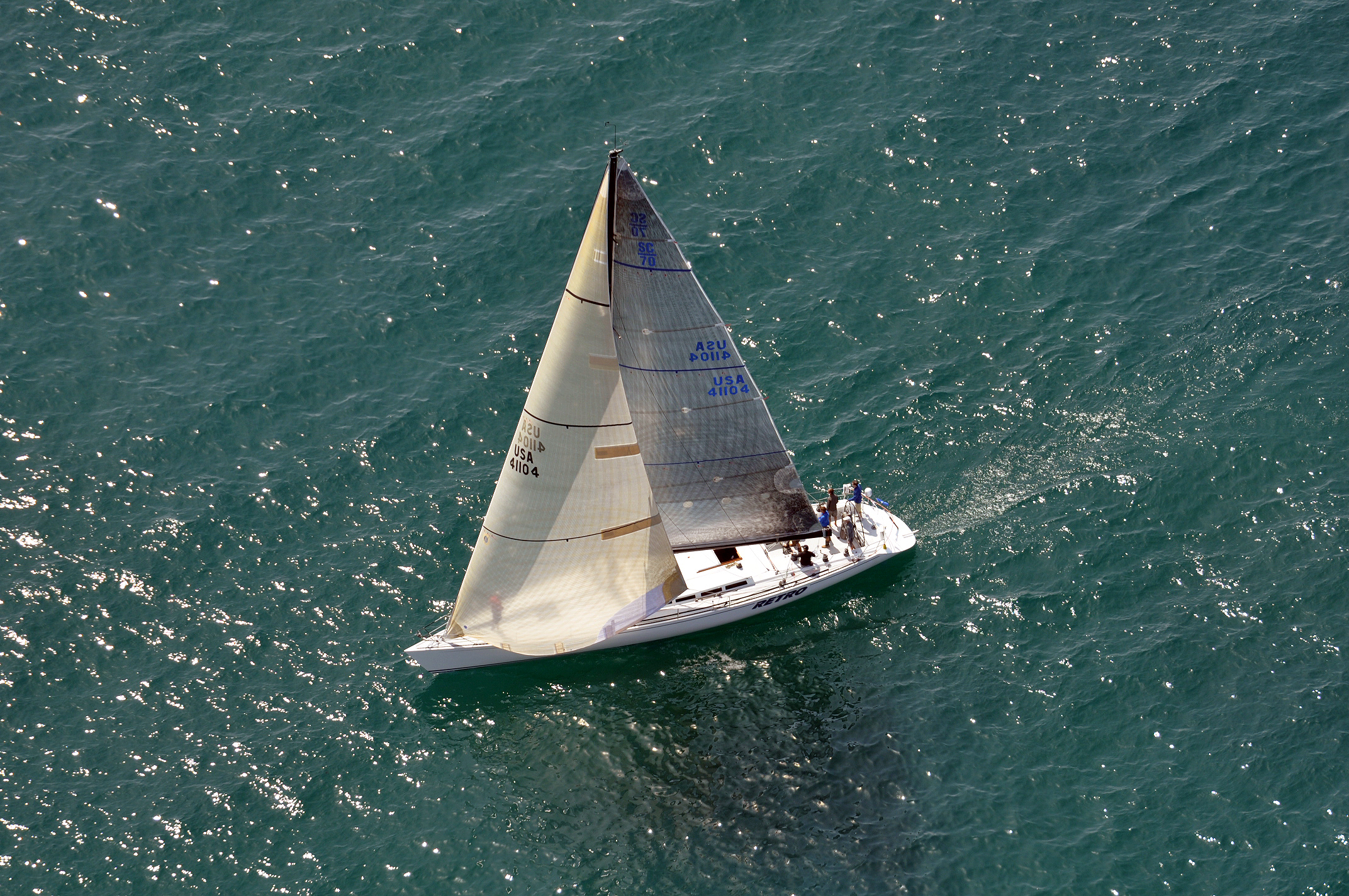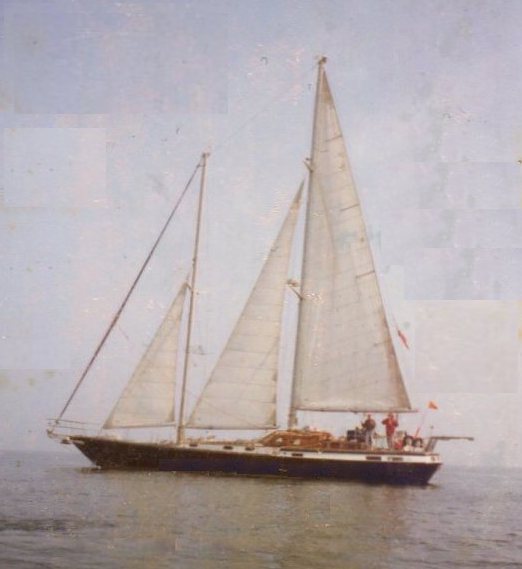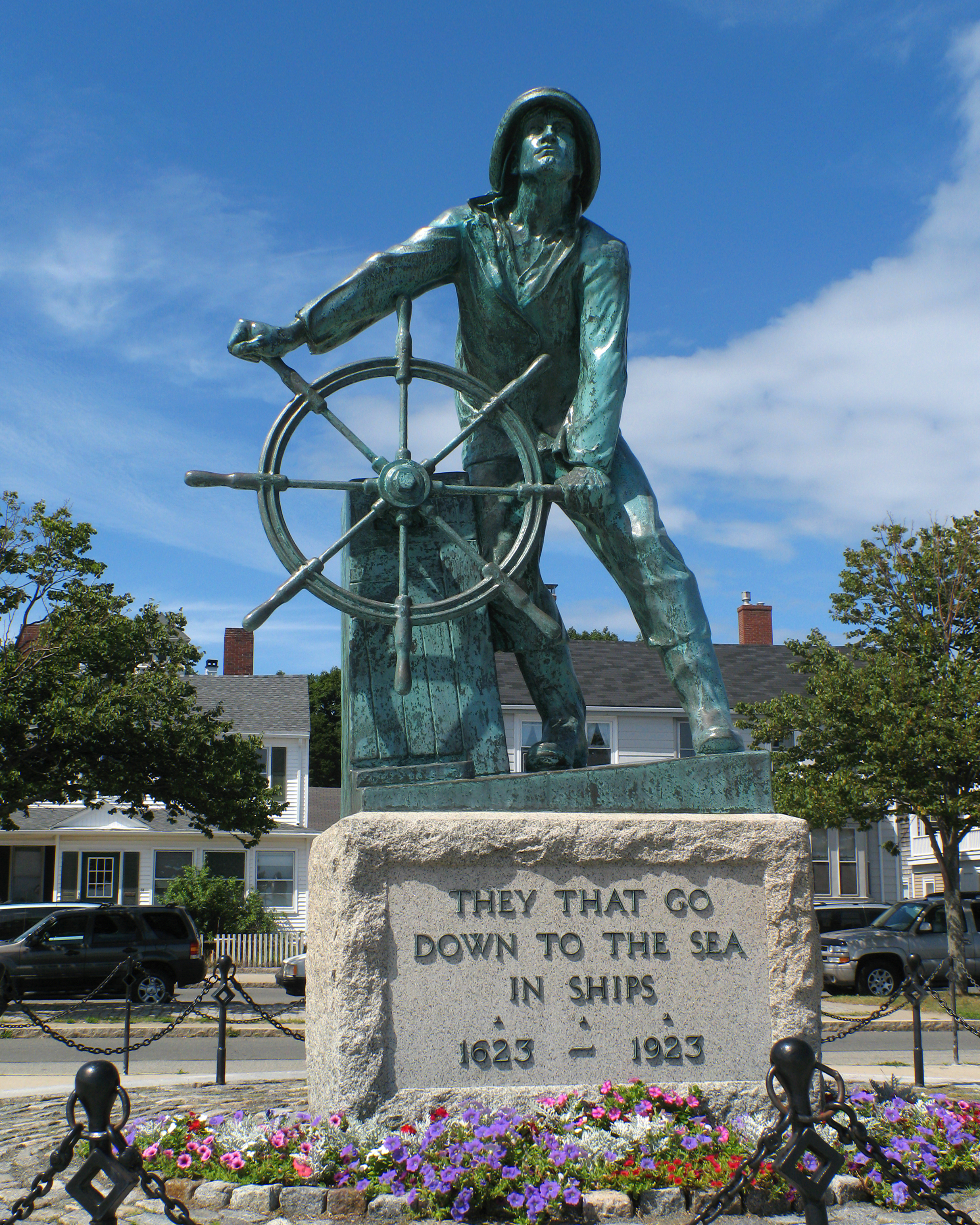|
Hunter 376
The Hunter 376 is an American sailboat that was designed by the Hunter Design Team as a cruiser and first built in 1996. The Hunter 376 shares a common hull with the Hunter 386 and the Hunter 380. Production The design was built by Hunter Marine in the United States between 1996 and 1998. Design The Hunter 376 is a recreational keelboat, built predominantly of fiberglass. It has a fractional sloop B&R rig, a raked stem, a walk-through reverse transom, an internally mounted spade-type rudder controlled by a wheel and a fixed wing keel or fin keel. It displaces and carries of lead ballast. The boat has a draft of with the standard wing keel and with the optional deep draft fin keel. The boat is fitted with a Japanese Yanmar diesel engine of . The fuel tank holds and the fresh water tank has a capacity of . The cabin headroom is . Factory standard equipment included a 110% roller furling genoa, four two-speed self tailing winches, anodized spars, marine VHF radio, ... [...More Info...] [...Related Items...] OR: [Wikipedia] [Google] [Baidu] |
Hunter Design Team
Hunter Marine is an American boat builder, now known as Marlow-Hunter, LLC, owned by David E. Marlow. The company also produces the Mainship powerboat brand. Marlow also owns and manufactures the Marlow Yachts brand consisting of long range power cruisers in the 37 to 110 foot range. The company is based in Alachua, Florida. The first boat design was a 25-foot (7.6 meter) long sloop, and another noted design was the Ocean racing sailboat the HC 50. History In the 1800s Henry Luhrs, a German immigrant, outfitted trading ships and owned a chandlery. His grandson, Henry, continued the family heritage on the New Jersey coast, building and repairing recreational and fishing boats. By the early 1960s Henry and his sons, John and Warren, were building over a thousand powerboats a year. Hunter was started in 1973 in Alachua, Florida, as a sailboat manufacturer. The early Hunter boats were designed by John E. Cherubini. In 1988 the company ran into trouble, as the founder, Luh ... [...More Info...] [...Related Items...] OR: [Wikipedia] [Google] [Baidu] |
Fiberglass
Fiberglass (American English) or fibreglass (Commonwealth English) is a common type of fiber-reinforced plastic using glass fiber. The fibers may be randomly arranged, flattened into a sheet called a chopped strand mat, or woven into glass cloth. The plastic matrix may be a thermoset polymer matrix—most often based on thermosetting polymers such as epoxy, polyester resin, or vinyl ester resin—or a thermoplastic. Cheaper and more flexible than carbon fiber, it is stronger than many metals by weight, non- magnetic, non- conductive, transparent to electromagnetic radiation, can be molded into complex shapes, and is chemically inert under many circumstances. Applications include aircraft, boats, automobiles, bath tubs and enclosures, swimming pools, hot tubs, septic tanks, water tanks, roofing, pipes, cladding, orthopedic casts, surfboards, and external door skins. Other common names for fiberglass are glass-reinforced plastic (GRP), glass-fiber reinforced plastic ... [...More Info...] [...Related Items...] OR: [Wikipedia] [Google] [Baidu] |
Solar Panel
A solar cell panel, solar electric panel, photo-voltaic (PV) module, PV panel or solar panel is an assembly of photovoltaic solar cells mounted in a (usually rectangular) frame, and a neatly organised collection of PV panels is called a photovoltaic system or solar array. Solar panels capture sunlight as a source of radiant energy, which is converted into electric energy in the form of direct current (DC) electricity. Arrays of a photovoltaic system can be used to generate solar electricity that supplies electrical equipment directly, or feeds power back into an alternate current (AC) grid via an inverter system. History In 1839, the ability of some materials to create an electrical charge from light exposure was first observed by the French physicist Edmond Becquerel. Though these initial solar panels were too inefficient for even simple electric devices, they were used as an instrument to measure light. The observation by Becquerel was not replicated again ... [...More Info...] [...Related Items...] OR: [Wikipedia] [Google] [Baidu] |
Anchor
An anchor is a device, normally made of metal , used to secure a vessel to the bed of a body of water to prevent the craft from drifting due to wind or current. The word derives from Latin ''ancora'', which itself comes from the Greek ἄγκυρα (ankȳra). Anchors can either be temporary or permanent. Permanent anchors are used in the creation of a mooring, and are rarely moved; a specialist service is normally needed to move or maintain them. Vessels carry one or more temporary anchors, which may be of different designs and weights. A sea anchor is a drag device, not in contact with the seabed, used to minimise drift of a vessel relative to the water. A drogue is a drag device used to slow or help steer a vessel running before a storm in a following or overtaking sea, or when crossing a bar in a breaking sea.. Overview Anchors achieve holding power either by "hooking" into the seabed, or mass, or a combination of the two. Permanent moorings use large mass ... [...More Info...] [...Related Items...] OR: [Wikipedia] [Google] [Baidu] |
CD Player
A CD player is an electronic device that plays audio compact discs, which are a digital optical disc data storage format. CD players were first sold to consumers in 1982. CDs typically contain recordings of audio material such as music or audiobooks. CD players may be part of home stereo systems, car audio systems, personal computers, or portable CD players such as CD boomboxes. Most CD players produce an output signal via a headphone jack or RCA jacks. To use a CD player in a home stereo system, the user connects an RCA cable from the RCA jacks to a hi-fi (or other amplifier) and loudspeakers for listening to music. To listen to music using a CD player with a headphone output jack, the user plugs headphones or earphones into the headphone jack. Modern units can play audio formats other than the original CD PCM audio coding, such as MP3, AAC and WMA. DJs playing dance music at clubs often use specialized players with an adjustable playback speed to alter the pitch a ... [...More Info...] [...Related Items...] OR: [Wikipedia] [Google] [Baidu] |
Depth Sounder
Echo sounding or depth sounding is the use of sonar for ranging, normally to determine the depth of water (bathymetry). It involves transmitting acoustic waves into water and recording the time interval between emission and return of a pulse; the resulting time of flight, along with knowledge of the speed of sound in water, allows determining the distance between sonar and target. This information is then typically used for navigation purposes or in order to obtain depths for charting purposes. Echo sounding can also be used for ranging to other targets, such as fish schools. Hydroacoustic assessments have traditionally employed mobile surveys from boats to evaluate fish biomass and spatial distributions. Conversely, fixed-location techniques use stationary transducers to monitor passing fish. The word '' sounding'' is used for all types of depth measurements, including those that don't use sound, and is unrelated in origin to the word ''sound'' in the sense of noise or to ... [...More Info...] [...Related Items...] OR: [Wikipedia] [Google] [Baidu] |
Knotmeter
Pitometer logs (also known as pit logs) are devices used to measure a ship's speed relative to the water. They are used on both surface ships and submarines. Data from the pitometer log is usually fed directly into the ship's navigation system. History All nautical instruments designed to measure the speed of a ship through water are known as logs. This nomenclature dates back to days of sail when sailors tossed a log attached to rope knotted at regular intervals off the stern of a ship. The sailors would count the number of knots that passed through their hands in a given period of time. Today sailors still use the unit of knots to express a ship's speed. The speed of the ship was needed to navigate the ship using dead reckoning, which was standard practice in the days before modern navigation instruments like GPS. During World War II, pitometer logs were often interfaced directly into warship fire control systems. This interface was necessary to allow gunnery and torpedo fi ... [...More Info...] [...Related Items...] OR: [Wikipedia] [Google] [Baidu] |
Marine VHF Radio
Marine VHF radio is a worldwide system of two way radio transceivers on ships and watercraft used for bidirectional voice communication from ship-to-ship, ship-to-shore (for example with harbormasters), and in certain circumstances ship-to-aircraft. It uses FM channels in the very high frequency (VHF) radio band in the frequency range between 156 and 174 MHz, inclusive, designated by the International Telecommunication Union as the ''VHF maritime mobile band''. In some countries additional channels are used, such as the L and F channels for leisure and fishing vessels in the Nordic countries (at 155.5–155.825 MHz). Transmitter power is limited to 25 watts, giving them a range of about . Marine VHF radio equipment is installed on all large ships and most seagoing small craft. It is also used, with slightly different regulation, on rivers and lakes. It is used for a wide variety of purposes, including marine navigation and traffic control, summoning rescue serv ... [...More Info...] [...Related Items...] OR: [Wikipedia] [Google] [Baidu] |
Genoa (sail)
A genoa sail is a type of large jib or staysail that extends past the mast and so overlaps the main sail when viewed from the side, sometimes eliminating it. It was originally called an "overlapping jib" and later a genoa jib. It is used on single-masted sloops and twin-masted boats such as yawls and ketches. Its larger surface area increases the speed of the craft in light to moderate winds; in high wind, a smaller jib is usually substituted, and downwind a spinnaker may be used. Definition The term ''jib'' is the generic term for any of an assortment of ''headsails''. The term ''genoa'' (or genny) refers to a type of jib that is larger than the 100% foretriangle, which is the triangular area formed by the point at which the stay intersects the mast, and deck or bowsprit, and the line where the mast intersects deck at the rail. Colloquially the term is sometimes used interchangeably with ''jib''. A working jib is no larger than the 100% foretriangle. A genoa is larger, with ... [...More Info...] [...Related Items...] OR: [Wikipedia] [Google] [Baidu] |
Roller Furling
Roller furling is a method of furling (i.e. reefing) a yacht's staysail by rolling the sail around a stay. Roller furling is typically used for foresails such as jibs or genoas. A mainsail may also be furled by a similar system, whereby the sail is furled within the mast or around a rotating boom (or around a rotating shaft within a boom). Although staysail roller-furling is effective and very common, in-mast or in-boom mainsail furling involves some compromises, and mainsail slab reefing gives a better sail shape. Methods The idea for a furling jib is usually attributed to Major E du Boulay in England who invented a device similar to a roller blind for reefing a jib. Major Wykeham-Martin used one of Boulay's rollers and improved the system by incorporating roller bearings in 1907 when the system was patented. The original castings were made by London-based toilet makers Bouldings. By the 1940s nearly every British cruising yacht was fitted with this furling system. An earl ... [...More Info...] [...Related Items...] OR: [Wikipedia] [Google] [Baidu] |
Keel
The keel is the bottom-most longitudinal structural element on a vessel. On some sailboats, it may have a hydrodynamic and counterbalancing purpose, as well. As the laying down of the keel is the initial step in the construction of a ship, in British and American shipbuilding traditions the construction is dated from this event. Etymology The word "keel" comes from Old English , Old Norse , = "ship" or "keel". It has the distinction of being regarded by some scholars as the first word in the English language recorded in writing, having been recorded by Gildas in his 6th century Latin work '' De Excidio et Conquestu Britanniae'', under the spelling ''cyulae'' (he was referring to the three ships that the Saxons first arrived in). is the Latin word for "keel" and is the origin of the term careen (to clean a keel and the hull in general, often by rolling the ship on its side). An example of this use is Careening Cove, a suburb of Sydney, Australia, where careening was carried ... [...More Info...] [...Related Items...] OR: [Wikipedia] [Google] [Baidu] |
Ship's Wheel
A ship's wheel or boat's wheel is a device used aboard a water vessel to steer that vessel and control its course. Together with the rest of the steering mechanism, it forms part of the helm. It is connected to a mechanical, electric servo, or hydraulic system which alters the horizontal angle of the vessel's rudder relative to its hull. In some modern ships the wheel is replaced with a simple toggle that remotely controls an electro-mechanical or electro-hydraulic drive for the rudder, with a rudder position indicator presenting feedback to the helmsman. History Until the invention of the ship's wheel, the helmsman relied on a tiller—a horizontal bar fitted directly to the top of the rudder post—or a whipstaff—a vertical stick acting on the arm of the ship's tiller. Near the start of the 18th century, a large number of vessels appeared using the ship's wheel design, but historians are unclear when the approach was first used. Design A traditional ship's wheel is comp ... [...More Info...] [...Related Items...] OR: [Wikipedia] [Google] [Baidu] |








